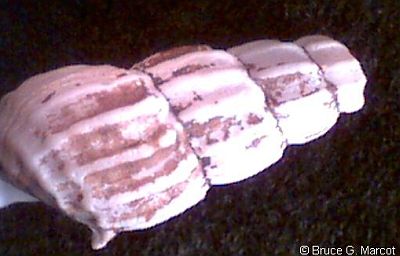Click on the image for a larger version

|
|
Fibonacci Spirals Are Everywhere |
|
|
Click on the image for a larger version

|
|
Fibonacci Spirals Are Everywhere |
|
Fibonacci or Logarithmic Spiral in Cone Shell |
Credit & Copyright: Dr. Bruce G.
Marcot
| Explanation: It
seems to be everywhere in nature! It's the Fibonacci spiral, a pattern
that follows the Fibonacci sequence of numbers: 0,1,1,2,3,5,8,13...
where the next number is simply the sum of the previous two numbers.
Also called the Bernoulli
spiral, logarithmic
spiral, equiangular
spiral, and This sequence may account for the apparent "self-similarity" of patterns found in many phenomena in nature -- like the logarithmic spiral of land snails (such as shown in the zoom animation at right shown at 10x, 60x, and 200x), the spiral of ancient nautilus shells, the patterns of reproduction of rabbits, and even patterns of hurricanes and galaxies.
The simplest form of self-similarity in nature seems to be from the Fibonacci spiral, which occurs as an organism grows such that its proportions remain constant. It is a simple recurrence
of pattern and ratios that create beautiful forms. With Fibonacci
spirals you can ponder
the meaning of life, explain
patterns in nature, or just
have fun! Addendum: Are
Fibonacci spirals really everywhere? I appreciate some rather pointed
emails from Donald Simanek challenging this idea. He has posted an interesting
essay suggesting that many (or most) instances of Fibonacci spirals are
specious interpretations of other patterns.
|
Next week's picture: Life on the Ice
Member Theme of Taos-Telecommunity